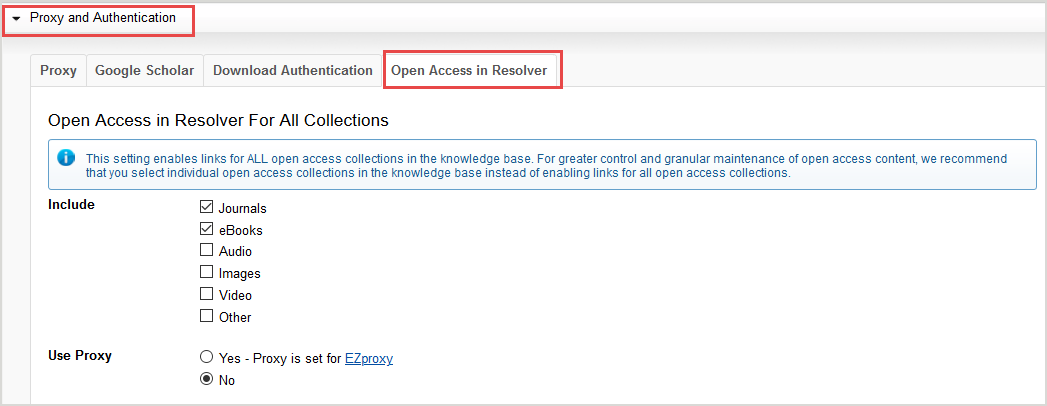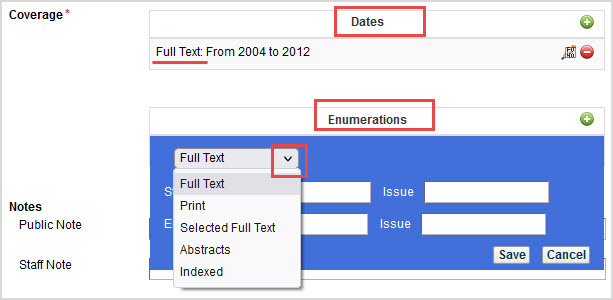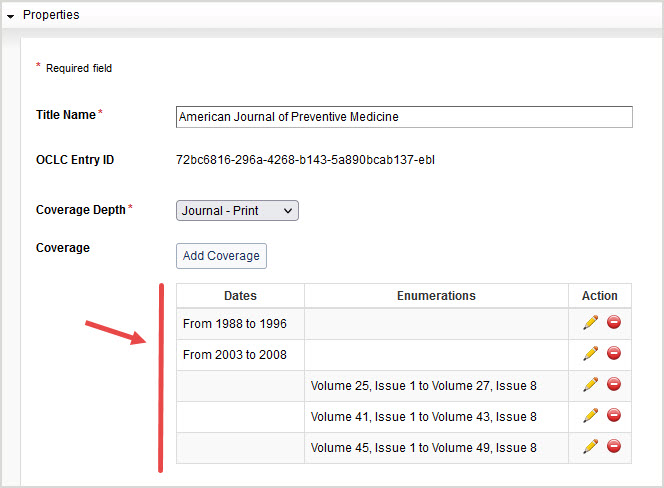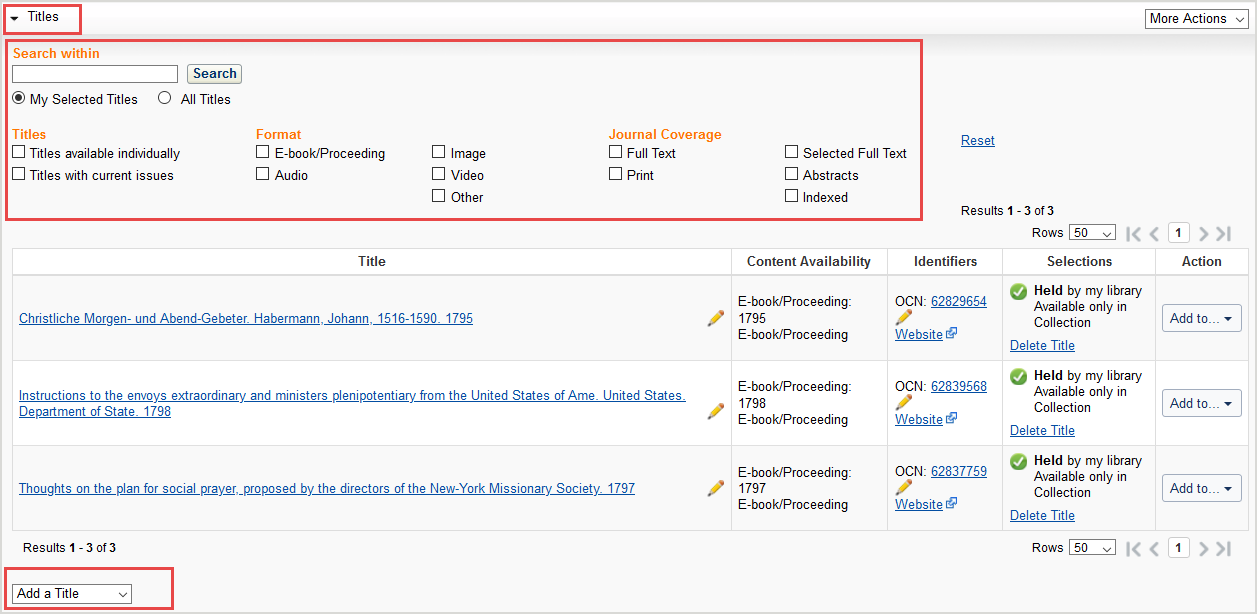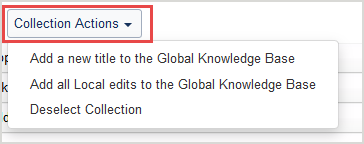Release notes: New features and enhancements
Video overview
Redesigned collections give you control
All collections are now customizable
We re-architected the way we ingest knowledge base data. This allowed us to change how the system tracks your collection and title-level selections over time. Enhanced processing allows all collections to be customizable, brings symmetry to the interface, and makes workflows more intuitive. This is one of the most-requested enhancements on the list!
Before
Some collections were non-customizable and could only be selected in full. Titles could not be edited. Differences in KBART requirements caused confusion. When creating a collection, you had to change a setting to make the collection customizable and if you did not, it could not be changed later.
If you selected a collection in full using the button in search results, you were not able to then delete some of the titles.
After
All collections are now customizable. We have removed the Customizable and Non-Customizable attributes and the pencil icons for a cleaner appearance in the interface. You no longer need to choose between Customizable and Non-Customizable when you create a knowledge base collection.
If you select a collection in full, you will no longer be restricted from making title-by-title deselections. You can select the collection using the button in search results and then enter the collection and deselect a title.
Your migrated data. Global collections that were non-customizable have been converted and now behave like customizable collections; The system now allows you to select and deselect individual titles. Any collections you had selected remain, as do your holdings in WorldCat and other settings.
If you created a local collection as non-customizable, it has been converted to a customizable collection.
Workflow changes to remember. When adding titles via a KBART spreadsheet, include a unique, numeric oclc_entry_id for every title. To represent multiple coverage ranges, use the same oclc_entry_id in each row.
New option to Auto Select Titles
It is easier than ever to select and deselect knowledge base collections and titles in the Collection Manager interface, regardless of whether the collection is selected in full or as a subset of titles.
Before
Customizable collections could be selected in full or a subset of titles could be selected. If selected in full, title deselections could not be made, and new titles added to the collection from data loads would not be automatically selected.
After
A new Auto Select Titles setting in global knowledge base collections enables functionality to automatically select titles as they are added from OCLC data updates. You can enable or disable the setting regardless of whether you have selected a collection in full or have selected a subset of titles.

The default setting depends on if you selected all or a subset of titles in a collection:
- All titles in a collection are selected - Enabled by default
- A subset of titles in a collection are selected - Disabled by default
Your migrated data. Collections that were selected in full will have the Auto Select Titles setting selected. Collections with a subset of titles selected will not have Auto Select Titles selected. There is no change in functionality change your collections. Rather, you now have an additional option to control if titles added by OCLC's provider data updates are automatically selected or not.
Workflow tips to remember. The default Auto Select Titles settings will serve your needs for many collections. However, you can enable or disable the setting at any time. For example, if you have all titles in a collection selected except for a few that are regionally restricted, the setting will be disabled by default. Enable Auto Select Titles if you want newly added titles to be automatically selected. Enabling the setting will not change your current title selections. Rather, titles added in future data updates will be automatically selected.
Removal of Open Access in Resolver
The Open Access in Resolver setting in Collection Manager > Institution Settings > Proxy and Authentication has been removed.
Previously, the Open Access in Resolver setting sent title and linking information from all knowledge base collections with the "open access" attribute to WorldCat Discovery. The setting did not select the collections or titles in your knowledge base and did not set holdings in WorldCat.
Sending links to Discovery in this manner caused numerous errant links. The setting was removed to reduce confusion. Libraries prefer the more precise method of selecting individual knowledge base collections. Selecting individual collections is easier to maintain and is congruent with other workflows around selecting collections.
New model for knowledge base collection editing
Removal of cooperative voting wait times
OCLC's WorldCat was created, in part, by the power of the cooperative. E-resources are adopting a more cooperative model. While the WorldCat knowledge base has had cooperative features for some time, we have enhanced workflows to make cooperative maintenance more accessible and removed features that libraries weren't using such as cooperative voting.
Before
Edits had to be submitted to be applied to the global title. Edits would be applied or denied as soon as the number of approval/denial votes met a collection-specific threshold of 10 or less (often 4 or 5). If the threshold was not met in either direction, the updates would be applied after 5 days. There was a 5-day wait for most changes because most changes did not receive enough approval/denial votes. Libraries had to wait to check the status of their edits and verify the results of the changes.
After
The knowledge base has been automatically applying libraries' changes after a wait period of 5 days. The wait period is now removed and your edits will be automatically applied. Thus, libraries will receive improved data faster and have an easier process for making cooperative edits, verifying the results of their work, and sharing them with other libraries. The Approve Changes to Global Collections button under the Collection Manager search box has been removed.
Workflow tips to remember. Although there is no longer a queue to review library-initiated changes, enhancements to the Activity History and to Collection and Title histories make it easy to see what global changes were made.
Edits to global fields are cooperative
In aligning with the WorldCat heritage, the WorldCat knowledge base was redesigned to give librarians more control over their content. All knowledge base libraries will automatically benefit from edits you make in global fields. When you edit global title data, the changes are automatically applied to the global title and received by all libraries.
Before
Edits to fields in global knowledge base collections would remain local as an overlay to the global data and available only to the library. To submit the improved data to the cooperative, the library had to take an extra step. It was time-consuming to keep checking the status of cooperative changes. For libraries that did not submit their edits, local and global copies in the system produced confusing title search results and titles were not updated with valuable global updates.
After
There are no additional steps to submit your edits to the cooperative and no wait time. You can edit global and/or local fields either in the Collection Manager user interface (UI) or via a KBART file. Some fields are specific to each library and edits to those fields will remain local to each library. The following fields will remain local:
- Journal coverage & enumeration
- Title-level URLs and linking
- 備註
New features designed to support this workflow:
- Visual markers are included at the point of need to make it clear when you are editing a global field: In the Collection Manager interface, Global and Local tabs indicate which fields are editable and how your edits will be applied.
- Preview screens aggregate your changes so you can review your edits: After you make edits, you can preview and confirm your work before you apply your edits.
- Fast processing times allow you to see the results of your edits without having to remember to sign back in later: Upon saving, your changes will be viewable in the Collection Manager interface nearly immediately.
- The Activity History tracks previous and new values and offers transparency: You can see what other libraries have edited by viewing a title's Title History. Likewise, you can search the main Activity History to see when a data load from a provider updated a collection and see what title changes were made.
Your migrated data. All your library-specific data such as coverage information, links, and notes will be retained. Edits that libraries promoted via the cooperative will also be retained.
If you made edits in global fields and did not promote the change, those changes will not be retained, with one exception: Changes made in global collections to the list of Grouped OCLC Numbers will be retained even if they were not promoted globally. The Provider Name is a global field populated by OCLC; it is not an editable field in global collections but remains editable in local collections.
After the rollout, all libraries will have refreshed global data. The values in global fields will be the same for all libraries. See the list of fields where locally saved edits will not be retained in the migration at the time of release.
Workflow tips to remember. When editing global collections, edits to global fields will be applied for all libraries shortly after you save your changes. In the Title History of each title that you edit, other libraries will see your institution's name as the source of the change.
Edits to some fields in global collections will be local to your library, for example: Journal coverage, note, and all linking fields. Coverage and linking fields often have a global value populated from provider data. If you edit that value, your edit will be local to your library and data updates will not overwrite it.
For more details:
- See the list of fields where locally saved edits will not be retained in the migration at the time of release
- See the documentation: Edit global collections and titles
Add titles in real time
Libraries can add titles to global collections without a wait time. When you add a title to a global collection, you will be able to enter data in all editable title-level fields. Once you save the title, the Global and Local tabs will appear and the fields in those tabs will function as they do within other global titles.
Libraries will not be able to delete global titles. OCLC can help.
Workflow tips to remember. Libraries can add global titles to global collections via the UI and via a KBART file using the ACTION value Add.
Newly written for this release: Best practices for adding global knowledge base titles
Improved workflow to promote collections
We have made the workflow that libraries use to promote local knowledge base collections more streamlined. It is now more intuitive to find global collections that other libraries have contributed.
Before
After a library promoted a local collection and it became a global collection, the local collection was not automatically removed. Libraries had an additional step to delete the local version of the collection.
There was no way to search or filter search results in Collection Manager to surface only global, library-contributed collections. The only way to find how many are in WorldCat knowledge base was to download the list of knowledge base collections from OCLC's website and filter it in a spreadsheet application for collections with a global.xxx Collection ID.
After
Once OCLC accepts a collection that you submitted for promotion to a global collection, the collection will be transformed, and you will not have a duplicate collection. The Collection ID will change from customer.xxx to global.xxx. The Provider Name will change and be symmetrical with all other cooperative collections: Promoted: Local to Global Cooperative.
In the main Activity History, you will see an activity for your local collection that shows the date and that it was accepted. If for any reason it is not accepted, you will see that OCLC was unable to accept it and a comment with the reason and/or change needed.
It is easy to find global collections created by libraries. Simply click on the Provider Name as you would for other providers: Promoted: Local to Global Cooperative

Your migrated data. If you had local duplicates of collections you promoted to the cooperative, the local versions have been migrated. OCLC migrated all local collections. The Provider Name for all global.xxx collections has been updated so it will function like the one that is automatically assigned: Promoted: Local to Global Cooperative.
Workflow tips to remember. Once OCLC accepts the local collection you have submitted for promotion, your local collection will be transformed automatically. The data in the title and collection histories will not be transferred to the global collection. However, an activity for your customer.xxx collection will remain in the main Activity History, so you have record of when it was accepted.
The Provider Name will be transformed to the following text when your collection is accepted, and the text will be hyper-linked: Promoted: Local to Global Cooperative
Redesigned modal improves coverage quality
New coverage modal in the UI
The redesigned coverage modal will improve data quality over time. This change was needed as we adopt a more cooperative modal. This enhancement also supports the improvements made around the workflow libraries use to promote local collections to the global cooperative.
Before
Coverage depth (like the value full text, indexed, or abstracts) was attached to coverage and had to be selected in both the date and the enumeration modals and for each row added.
To add coverage information, libraries had to add a date range and then take another action to add volume and issue numbers. When libraries downloaded KBART files for their local collections, if the collection had titles with multiple coverage ranges, coverage would not always be paired correctly in the file.
After
Titles that have more than one coverage depth will appear as two titles with unique OCLC Entry IDs. This change increases options for future enhancements. For example, some libraries have requested that OCLC extend the functionality of indexed titles so they appear in the WorldCat Discovery A-to-Z list.
The modal in the interface was redesigned so that date and enumeration pairs can be entered in accordance to how librarians experience them.
In a global title, coverage is only editable in the Local tab. Dates and Enumerations are aligned from left to right. To add another row of coverage, use the Add Coverage button.
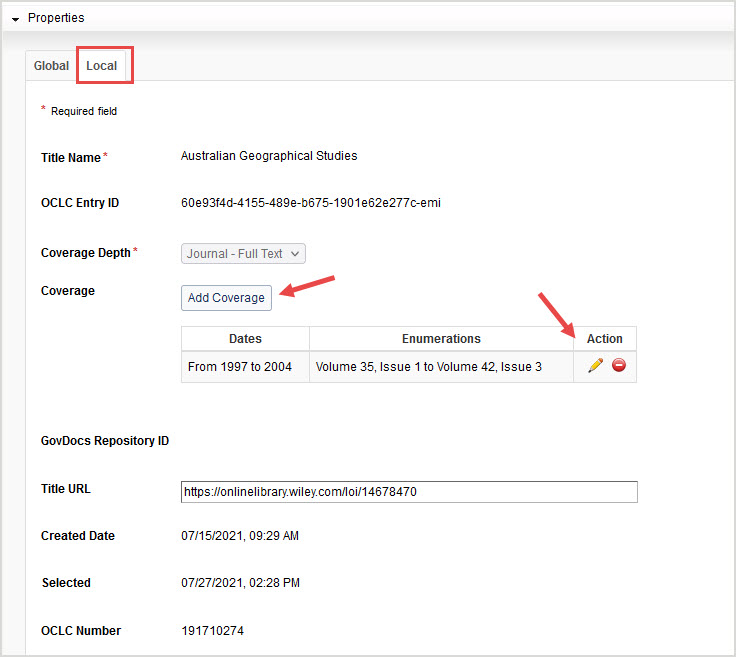
After you click the Add Coverage button or on the pencil icon, the enhanced modal opens.
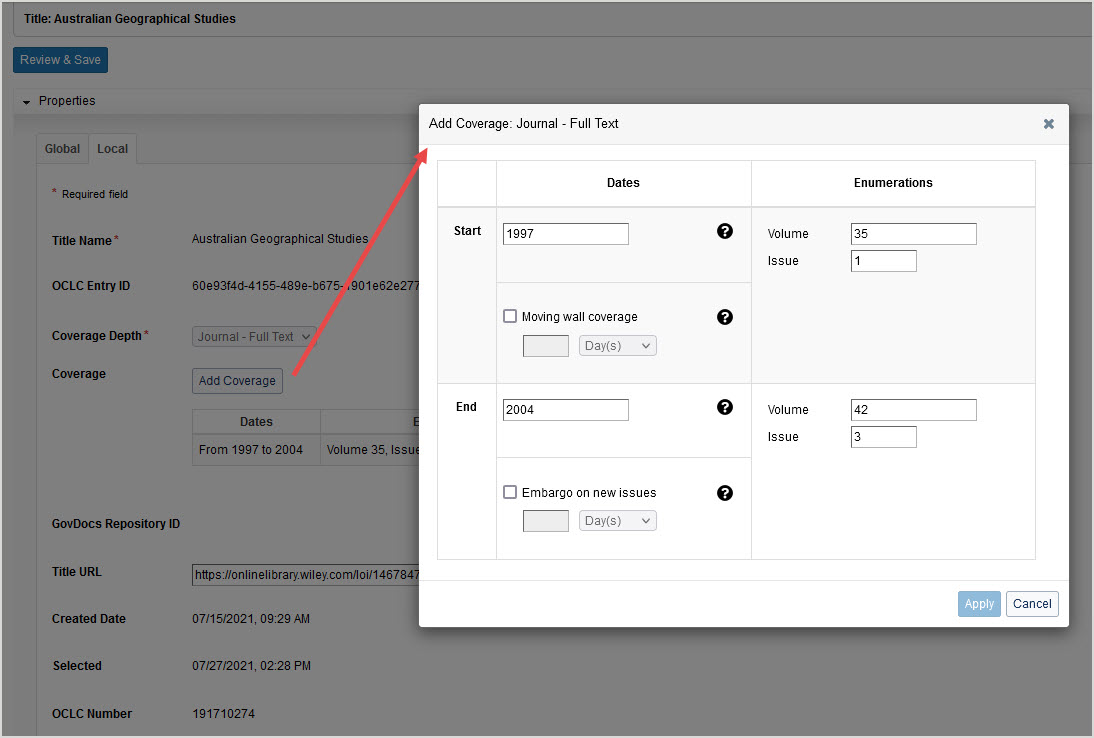
Your migrated data. Titles that have more than one coverage depth have been separated and will appear as two titles in the Titles accordion and they each have OCLC Entry IDs.
Titles that had one date and one enumeration will be paired during migration. Pertaining mostly to local collections, titles with more than one date and/or enumeration range will appear in the modal and will be unpaired. The data was not altered by migration. Thus, link behavior in WorldCat Discovery is not impacted.
Workflow tips to remember. To represent an additional coverage depth, for example, if you own a journal in full text and want to keep record that you also own abstracts:
- In the UI: Add another journal title and assign the appropriate coverage depth, or
- If using a KBART file: Include a row for each coverage depth and use a unique oclc_entry_id in each row
Coverage depth is editable in local collections
Libraries now have the option to edit coverage depth in local collections. Previously, libraries could not edit the field in local collections once a title was created. The values have been re-named so that it is clear which ones are associated with journals:
Audio
Ebook
Image
Journal - Abstracts
Journal - Full Text
Journal - Indexed
Journal - Selected Full Text
Journal - Print
Video
Other
OCLC announced in the 13 November 2019 Product Insight session that OCLC was planning to make coverage depth editable in all collections. We have since determined that OCLC will oversee the changes for global collections. If you find global titles where the coverage depth needs to be changed, please contact OCLC Support.
New preview screens for edits and uploads
Review edits you make in the interface
We are introducing new preview screens to support the new model for cooperative editing. Preview screens allow you to review and confirm your edits before you apply them.
In global knowledge base collections, edits you make in collection and title fields in the Collection Manager interface will be applied globally or locally. Editable fields appear in the Properties accordion, the Linking accordion, and within each title. Each of these locations has a Global tab and a Local tab where fields are available for editing respective to the tab.
After you make edits in one or in both tabs, you will find a new Review & Save button at the top of the screen. When you click the button, a summary screen will aggregate your edits from the Global and Local tabs.

The information in the summary allows you to verify the global or local application of the changes. If you are not satisfied with the edits, you can cancel the changes. Changes will be tracked via the Activity History and viewable within the title's Title History accordion.
Preview your KBART file uploads
Like the enhancements added to Collection Manager for making global and local edits in the user interface, new features have been added to the KBART upload workflow support to the new model for cooperative editing.
- A new Upload Preview gives you an opportunity to verify changes before applying them
- Messaging in the interface keeps you informed about the status of your upload
- Redesigned Activity History pages including a Loads & Feeds filter offer insight into updates and the source of the changes
- KBART uploads to global collections now offer you a report with your local changes and/or title selections and a second report that will be available to all libraries that shows global edits
When you upload a KBART file to a collection:
- A message will appear above the collection-level accordions saying that your upload is being processed. When the initial processing is complete, you will see a second message saying that your upload preview is ready. You have 72 hours to view the report and approve or discard the upload.

- The Upload Preview will include the number of rows that, upon your approval, will be processed. It will include the number of titles added, selected, and edited globally and/or locally.
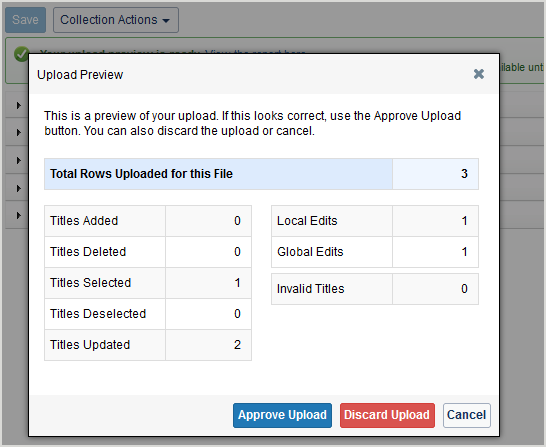
- After reviewing the information, click on one of the buttons: Approve Upload, Discard Upload, or Cancel. Once you approve an upload, the collection will be locked for indexing for a short time.

- After the changes are applied, your file upload will show as an event in the main Activity History. Updated title information will show within each title's Title History.
Other libraries will see activity when you make globally applied edits. They will see only global changes and will see your institution's name.
Workflow tips to remember. After you upload a KBART file, there is an additional step to view an upload preview and approve the changes. You can wait until the preview is generated or exit the WorldShare interface and return within 72 hours to find the preview within the collection.
After you approve a KBART upload to a global collection, an event will appear in the main Activity History. If your file included both global and local changes/title selections, you would see two events. The event that shows the global changes will be available to all libraries. In other libraries' accounts, your institution's name will show as the source.
Improved Collection Manager Activity History
The Activity History was completely redesigned to bring you more transparency and insight into dynamic changes in your collections that occurred in the previous 90 days.
Highlights:
- Access is integrated with the search box: Access the Activity History by choosing the option as the Collection Manager search scope. Multiple search filters are now available to help you quickly find the information you need.
- A new setting allows you to see personal names: A new option in Collection Manager > Institution Settings > Display Options allows you to see in the Activity History the name of the person at your institution that made edits, selections, and so forth. When the setting is enabled, only the name of your institution will show externally to other libraries; Only members of your institution will see staff names.
- Query and Cataloging Partner collection activities are now included: Use the new Collection History accordion to see the date the collection was created, MARC record delivery was enabled, and so forth.
- Knowledge base titles have enhanced Title Histories: The Title History makes it easy to see changes to global titles, the source of the edits, and the previous and updated data. You can filter for local edits made by your library.
- Load and feed activities include a detailed Title Changes page: See previous and updated data, number of titles updated, and more right in the interface!
Watch the Product Insight presentation about this topic.
For more details, see documentation: Activity History
Updated Collection Manager search
Additional searchable fields
It is now easier to search for collections and titles in WorldShare Collection Manager. When searching in the search box, you have expanded options for finding specific titles and for surfacing all the titles with a certain note or location.
The Collection Manager search functionality is mirrored in the WorldShare Acquisitions and WorldShare License Manager applications.
Before
By changing the search Scope to Title, you were able to search for titles by OCLC Number, ISBN, and ISSN.
After
You can search across additional fields such as Staff Note, Public Note, and more.
You can also perform searches using truncation (*). For example, searching with science* returns results starting with science such as:
- Science and Technology
- Science Reference
- ScienceDirect All Books
館藏搜尋結果
We've made changes to the interface to improve your experience. By removing unnecessary distractions and confusing notations, we've modernized the appearance of search results in Collection Manager.
Before
Search results were cluttered with pencil icons, "Customizable" and "Non-Customizable" attributes, and confusing statements like "Available only in Collection." Coverage information was difficult to read.
After
The interlace is cleaner and makes it easier to visually scan collections and titles.
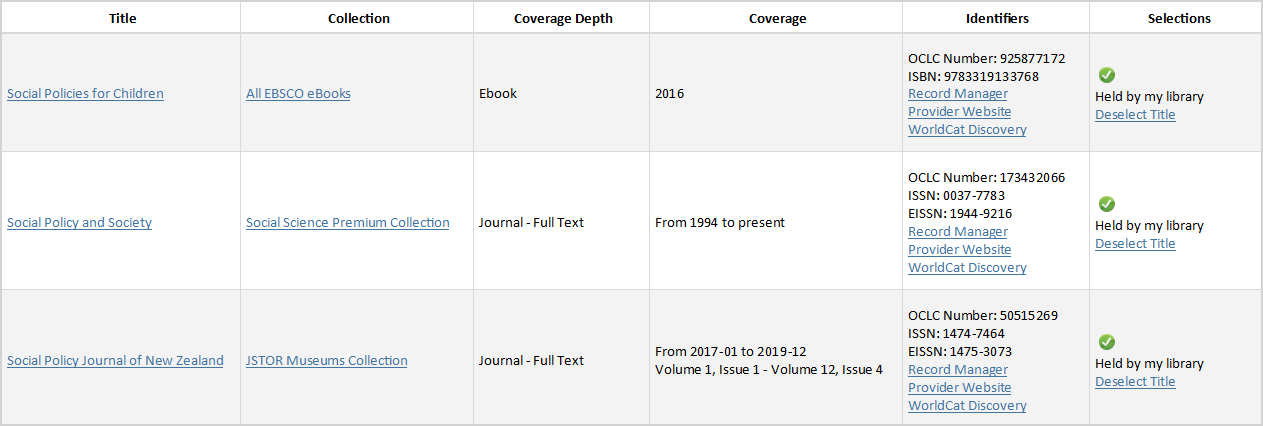
Main search filters
Searching for your collections in Collection Manager will be faster and easier with reconfigured options to filter your search results.
Before
Previously, some filter options were hidden in additional fly-out menus. For example, to surface collections you created or any collection that was shared, the filter option was hidden and only visible after clicking on the "Collections..." option. Libraries often did not know the additional filters were available.
After
With this release, the filter options are easy to read. You can filter your search results from a single menu after you perform a search in Collection Manager.
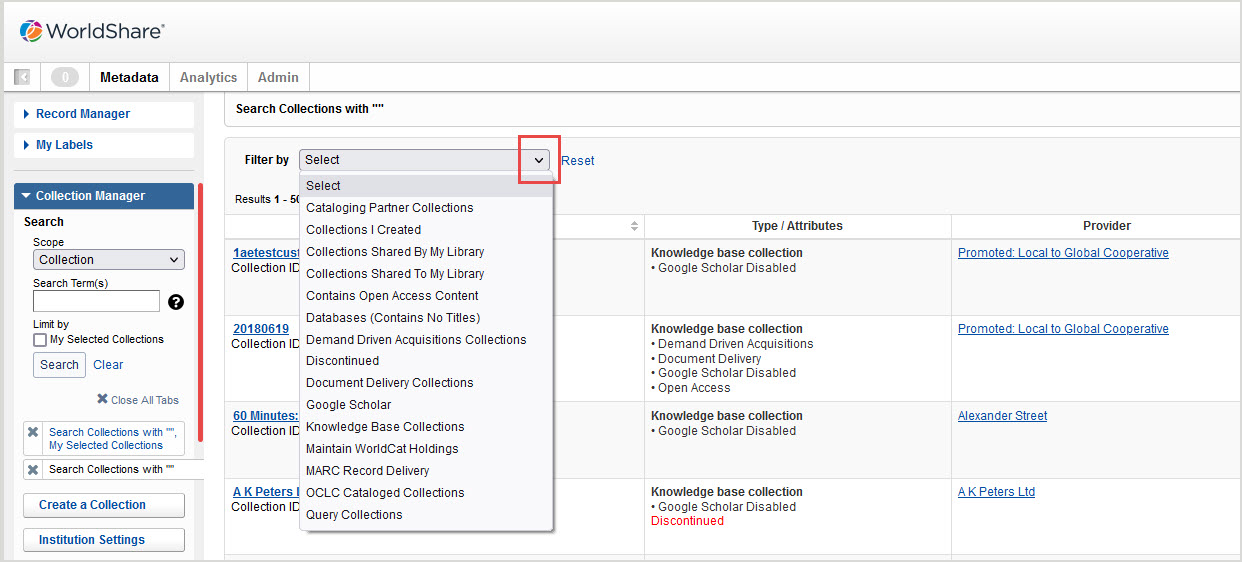
Title search filters
Title search screens have a cleaner appearance and search filters are collapsed so users do not need to read them until they need to choose a filter.
Before
When performing a title search, numerous search filters and check boxes cluttered the top of the screen.
After
The filters have been collapsed into an easy-to-use drop-down menu that allows you to filter your search results to those of a specific format/coverage depth.
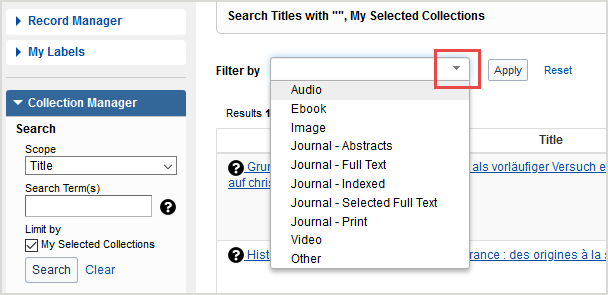
For a consistent experience, the same filters are available when searching across all titles from the Collection Manager search box and when searching for a title within a collection.
Intuitive menus for workflow actions
Collection Actions: KBART download
The options to download or upload a KBART file to a collection have moved to a more intuitive location. The options are easier to find because they follow the standard of being on the top, left side of the screen.
Before
The KBART file options were located within a collection's Titles accordion even though downloading or uploading a file is a collection-level action. The option was on the right-hand side of the screen which was atypical for menus and buttons in Collection Manager. It was therefore easy to miss.
After
The options to download or upload a KBART file are located above the collection-level settings within the Collection Actions drop-down menu.
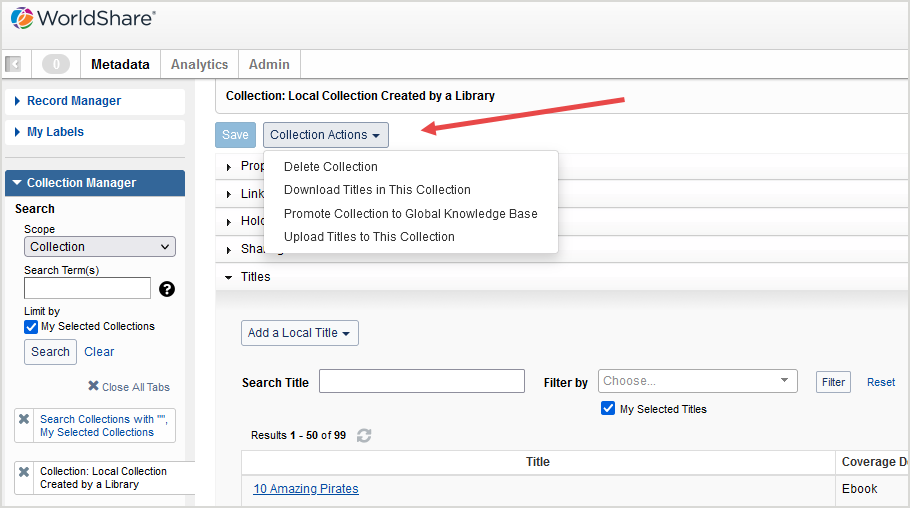
Collection Actions differ for global and local collections; only the relevant actions show in the interface. Both types of collections include the option to download a KBART file: Download Titles in This Collection.
The Collection Actions in local collections are:
- Delete Collection
- Download Titles in This Collection
- Promote Local Collection to Global Cooperative
- Upload Titles to This Collection
The Collection Actions in global collections are:
- Deselect Collection
- Download Titles in This Collection
- Upload Titles to This Collection
Workflow tips to remember. When you go to download a KBART file from a global collection, a modal box will open. The button will say Download or Generate Download. KBART files for global collections are generated 1/day. If a file is already available on the server, you will see the Download button. See a list of all KBART related enhancements in this release.
Add a Title within a collection
We have moved options in the interface to more intuitive locations, paying special attention to those that are used to take an action, for example, to add a title. We also created more symmetry between global and local collections making workflows for each more natural.
Before
When you expanded the Titles accordion within a knowledge base collection, the screen had a search box with many checkboxes to use to filter by format or coverage depth.
The option to add a title to a local collection was in the Add a Title drop-down menu. If there were more than a few titles in the collection, it was difficult to notice the drop-down menu since it was located below the list of titles and the menu was also only found in local collections. The option to add a title to a global collection was in a different location. It was in the Collection Actions drop-down menu.
After
Search filters have been collapsed into a drop-down menu, removing potentially unnecessary text from the screen. The option to add a title is in the same location in both global and local collections. The drop-down menu to add a title says Add a Global Title or Add a Local Title, respectively.

Enhanced knowledge base collection sharing
Helpful notifications replace quiet errors
Enhancements to collection-by-collection sharing give libraries more control, ensure that libraries encounter fewer error messages, and restore data integrity. These enhancements, along with the change to make all collections customizable, make it easier to create and share collections and manage collections as subscriptions change over time.
Before
Libraries that shared a collection would receive an error message when trying to unshare, deselect, or delete a collection. Those actions could not be performed unless the accepting library unaccepted the shared collection. This was problematic and time consuming for some libraries. It also caused discrepancies in title counts between libraries. Collections would remain selected even when they contained 0 titles and libraries could not deselect them.
Additionally, search results were confusing when both a standard and a shared collection were available. Libraries did not always realize that the alternative version of the collection was available, and the interface did not give any notification.
After
The system allows you to unshare a collection without giving you an error message or forcing the accepting library to first deselect the collection. This enhancement makes collection-by-collection sharing easier to manage.
When both a standard and shared version of a collection is available, the system will not allow you to select two copies of the same collection. If you have selected one of the collections and attempt to select the other version, you will be notified in the interface. An Unable to Select Collection modal will appear saying "You must deselect the currently selected collection before you are able to select this collection." You will have the option to deselect the collection you have selected and select the alternative version.
A new Sharing Activity filter has been added to the Activity History. Filter by:
- Sharing Accepted (by another Institution)
- Shared by My Library (to another Institution)
- Shared to My Library From (from another Institution)
Your migrated data. Your collection-level shared/accepted relationships have been preserved.
Workflow tips to remember. Communicate with libraries before unsharing, deselecting or deleting a collection. As the library that initiated sharing, you can discontinue a share and when you do so, the accepting library will not be notified by the system.
To find the collections you have shared or accepted, perform a search, and use the drop-down menu above the search results. New filter options have been added so you can easily filter your results for shared collections.
For more details, see the documentation: Share knowledge base collections
Removal of bulk Share All
The options to bulk share and subscribe to all of another library's knowledge base collections were removed to support a more cooperative design and correct bugs. The functionality to "Share All" was implemented before cooperative management features were fully developed.
Before
There were settings to bulk share all of a library's knowledge base collections, but use of the option caused confusion for libraries, errors, and database discrepancies and lack of visibility and control between shared accounts made synchronized collections difficult to maintain.
After
The institution-level Sharing accordion in Collection Manager > Institution Settings has been removed. Multiple data issues have been resolved and collection-level sharing has been enhanced to give you a more stable platform and an accurate view of which libraries accepted a collection.
Your migrated data. OCLC migrated your collections for you. For libraries with one or more collection accepted from bulk sharing, OCLC removed the Share All relationship and converted the selected collections to collection-by-collection sharing. Collections that were shared via bulk sharing and appeared in search results but were not selected were not migrated.
Workflow tips to remember. When you create a knowledge base collection with unique content that is accessible by other libraries, consider promoting the collection. As a global collection, all knowledge base users will have the option to select the collection and can help with maintenance.
You have the option to, in one action, share a single collection with multiple libraries.
Additional third-party upload option: Alma
You can now use the contents of your third-party knowledge base to start building out your collections in OCLC's WorldCat knowledge base. We have added Alma as an upload type in the Alternate Knowledge Base Supplier Holdings File* settings.
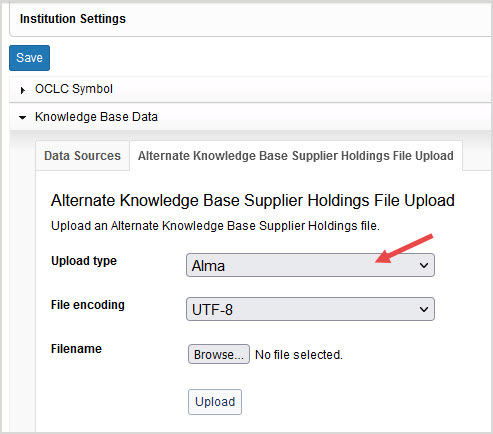
*formerly called Alternative Service Provider [ASP]

